"This is the Seventh Sign: You will hear of the sea turning black, and many living things dying because of it."On Wednesday 21st April an explosion rocked an offshore oil drilling platform in the Gulf of Mexico, sending a column of fire into the sky and claiming the lives of 11 oil workers. 52 miles southeast of Venice, Louisiana, Deepwater Horizon was built in 2001 by Hyundai Heavy Industries Shipyard in South Korea. It was owned by Houston based Transocean Ltd, under contract to British Petroleum Plc. Almost immediately a federal lawsuit was filed on behalf of one of the victims in New Orleans, Louisiana, alleging the companies connected to the oil rig explosion were negligent.
White Feather, a Hopi of the ancient Bear Clan.
The mainstream media has been performing consistently in downplaying just how catastrophic this disaster is, for marine life in the Gulf of Mexico, for inhabitants along the coast and, depending on how this plays out, possibly for the entire planet. Never before has the blind greed of so few been so immediately damaging and obvious to so many. Let us hope that the shock, revulsion and anger generated by this truly catastrophic event inspires masses of people to see how the psychopaths that rule our world guide humanity's destructive trajectory towards oblivion for all life on Planet Earth.
Thursday 22nd April - CNN cites the U.S. Coast Guard stating that the oil rig had sunk and that crude oil was leaking at the rate of about 8,000 barrels per day.
Thursday 29th April - CNN reported that the estimated amount of oil leaking from the sunken rig increased to as much as 5,000 barrels a day - "five times more than what was originally believed" - 2/3 less than they had reported 5 days previously.
Friday, 30th April - A former contractor whistleblower who worked for British Petroleum (BP) reports that the oil conglomerate broke federal laws and violated its own internal procedures by failing to maintain crucial safety and engineering documents related to one of the firm's other deepwater production projects in the Gulf of Mexico.
A confidential government report on the unfolding spill disaster in the Gulf makes clear that the Coast Guard now fears the well could become an unchecked gusher shooting millions of gallons of oil per day into the Gulf. "Two additional release points were found today in the tangled riser. If the riser pipe deteriorates further, the flow could become unchecked resulting in a release volume an order of magnitude higher than previously thought."
Friday, 30th April - Giant oil-services provider Halliburton may be a primary suspect in the investigation into the oil rig explosion that has devastated the Gulf Coast, the Wall Street Journal reports.
Though the investigation is still in its early stages, drilling experts agree that blame probably lies with flaws in the "cementing" process - that is, plugging holes in the pipeline seal by pumping cement into it from the rig. Halliburton was in charge of cementing for Deepwater Horizon.
An increase in the number of deaths of turtles is reported as they swim closer to shore to nest and shrimping season gets into full swing along the upper Texas coast.
Saturday, 1st May - Natural News reports that nearly 50% of the seafood consumed by Americans comes from the Gulf of Mexico. Even before the oil spill, the Gulf of Mexico is home to one of the planet's largest ocean "dead zones" - over 6,000 square miles of dead water where fish can't even survive. "Ninety-seven percent of commercial fish and shellfish in the Gulf depend on estuaries and wetlands during their life cycle," said Jane Lubchenco, head of the National Oceanic and Atmospheric Administration. Those wetlands are about to be covered with a thick brown slime that will make reproduction of seafood species virtually impossible.
Pressure builds for the US to release worst-case scenario estimates so residents of the Gulf Coast can adequately prepare. Independent scientists estimate that the renegade wellhead at the bottom of the Gulf could be spewing up to 25,000 barrels a day. If chokeholds on the riser pipe break down further, up to 50,000 barrels a day could be released, according to a National Oceanic and Atmospheric Administration memo obtained by the Mobile, Alabama Press-Register. Stuart Smith, an environmental attorney in New Orleans, said in a statement. "Why are BP and the Environmental Protection Agency not releasing such information to the public?
Sunday, May 2nd - BP begins drilling a relief well that could permanently plug the leak, an effort that will take 90 days to complete.
Monday, May 3rd - The spill more than triples in size to 4,000+ square miles - about the same size as Chesapeake Bay. The slick is so big, it is visible from space.
The National Iranian Drilling Company (NIDC) offers to assist the US in efforts to prevent an ecological disaster caused by the spreading oil spill in the Gulf of Mexico. NIDC managing director Heidar Bahmani announced "Our oil industry experts in the field of drilling can contain the rig leakage in the Gulf of Mexico and prevent an ecological disaster in that part of the world."
ABC and NBC morning news shows spend 30 seconds on the main news updates before changing tack completely. NBC viewers were treated to a special guest appearance by "Elmo" the talking puppet. "Elmo" engaged in childish and mindless chatter with the Today show clown Al Roker, and then with the queen of fake emotions, Ann Curry. The "Elmo idocy" was then followed by a segment on "plus-size models" and women's self esteem.
An engineer with 25 years of experience explains what "Elmo" didn't: That the Mother of all gushers could kill the worlds oceans:
First, the BP platform was drilling for what they call deep oil. They go out where the ocean is about 5,000 feet deep and drill another 30,000 feet into the crust of the earth. This it right on the edge of what human technology can do. Well, this time they hit a pocket of oil at such high pressure that it burst all of their safety valves all the way up to the drilling rig and then caused the rig to explode and sink. Take a moment to grasp the import of that. The pressure behind this oil is so high that it destroyed the maximum effort of human science to contain it.Wednesday, 5th May - The New York Times reports about a closed-door briefing for members of Congress. "A senior BP executive conceded Tuesday that the ruptured oil well in the Gulf of Mexico could conceivably spill as much as 60,000 barrels a day of oil, more than 10 times the estimate of the current flow."
When the rig sank it flipped over and landed on top of the drill hole some 5,000 feet under the ocean.
Now they've got a hole in the ocean floor, 5,000 feet down with a wrecked oil drilling rig sitting on top of it spewing 200,000 barrels of oil a day into the ocean. Take a moment and consider that, will you!
First they have to get the oil rig off the hole to get at it in order to try to cap it. Do you know the level of effort it will take to move that wrecked oil rig, sitting under 5,000 feet of water? That operation alone would take years and hundreds of millions to accomplish. Then, how do you cap that hole in the muddy ocean floor? There just is no way. No way.
The only piece of human technology that might address this is a nuclear bomb. I'm not kidding. If they put a nuke down there in the right spot it might seal up the hole. Nothing short of that will work. [See Paul Noel's ideas below]
If we can't cap that hole that oil is going to destroy the oceans of the world. It only takes one quart of motor oil to make 250,000 gallons of ocean water toxic to wildlife. Are you starting to get the magnitude of this?
Looking at what past spills have done to ecosystems, the prognosis for the Gulf of Mexico and the world's oceans is not good. Under the wrong conditions, oil can linger for decades and longer, causing permanent damage.
A 2002 study by British researchers suggests mangrove swamps are exceptionally vulnerable to oil spills. The Gulf is home to the only mangrove swamps in the continental United States, so the BP disaster could not have happened in a worse place.
BP said that it would have a giant, 100-ton dome-like device placed over the wellhead Thursday, which could begin to collect oil as soon as the following Monday.
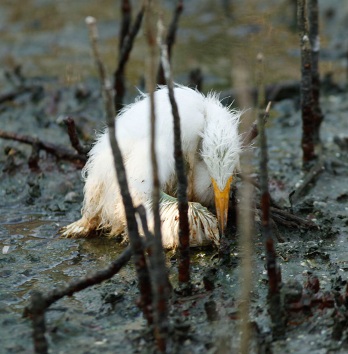
Thursday, 6th May - It is revealed that a rule change two years ago by the Minerals Management Service (MMS), the federal agency that regulates offshore oil rigs, allowed BP to avoid filing a plan for handling a major spill from a blowout at its Deepwater Horizon project - exactly the kind of disaster now unfolding in the Gulf of Mexico. An AP review of BP's regional oil-spill plan found that it failed to specifically address all of the points required by the MMS in a blowout scenario. It is not surprising to find out that In 2008, the Interior Department took disciplinary action against eight MMS employees who accepted lavish gifts, partied and - in some cases - had sex with employees from the energy companies they regulated.
Friday, 7th May - BP's internal investigation finds the deadly blowout of an oil rig in the Gulf of Mexico was triggered by a bubble of methane gas that escaped from the well and shot up the drill column, expanding quickly as it burst through several seals and barriers before exploding when it hit the Deepwater Horizon rig.
Saturday, 8th May - BP faces over 200 class action lawsuits from people seeking damages from the spill. BP had issued 17-page long agreements to fishermen who wanted to work in the oil spill clean up. According to M. Orr, BP wanted to have the fishermen "sign away their rights" [...] "It said that fishermen would have to have their own [health] insurance and not BP's. They also couldn't tell anyone what they saw. It took away their rights to sue BP if they got sick from the chemicals."
Are we witnessing an extinction event?
If it's true that millions upon millions of gallons of crude oil are flooding the Gulf with no end in sight, the massive oil slicks being created could make their way into the Gulf Stream currents, which would carry them not only up the East Coast but around the world where they could absolutely destroy the global fishing industries.Sunday, 9th May - The dome that took two weeks to build and three days to cart out, fails. BP says it will take 48 hours to "assess and put forward a new solution." As they were placing the dome over the leak source a large volume of methane hydrates formed inside the top of the dome. These hydrates are highly flammable and present a danger to BP workers on ships above the leak. If they dethaw in an uncontrolled manner, they could send a flood of natural gas to the top of the ocean surface and potentially ignite. It's clear that there is more than gushing oil to worry about.
Already these slicks are making their way into Gulf wetlands and beaches where they are destroying birds, fish, and even oyster beds. This is disastrous for both the seafood industry and the people whose livelihoods depend on it. It's also devastating to the local wildlife which could begin to die off from petroleum toxicity. Various ecosystems around the world could be heavily impacted by this spill in ways that we don't even yet realize.
There's no telling where this continuous stream of oil will end up and what damage it might cause. Theoretically, we could be looking at modern man's final act of destruction on planet Earth, because this one oil rig blowout could set in motion a global extinction wave that begins with the oceans and then whiplashes back onto human beings themselves.
A recent study by the Minerals Management Service pegged methane hydrate resources in the Gulf of Mexico at 21,000 trillion cubic feet of natural gas - 100 times the country's current proven supply.
Meanwhile, thick blobs of tar washed up on Alabama's white sand beaches, yet another sign the spill was worsening.
"Top Kill" planned and 'big box' put somewhere else. Pure semantics from BP: "I wouldn't say it's failed yet," BP chief operating officer Doug Suttles said of the containment box. "What I would say is what we attempted to do ... didn't work."
'Flummoxed' BP engineers ask public for oil leak solutions. Well, these two farmers presented a brilliant cost-effective solution, but were completely ignored. A massive spill off Saudi Arabia in 1993, pretty much censored from history until now, dumped nearly 800 million gallons of oil into the Persian Gulf, which would make it more than 70 times the size of the Exxon Valdez spill. But remarkably, by employing a fleet of empty supertankers to suck crude off the water's surface, a dedicated team was not only able to clean up the spill, but also salvage 85 percent of the oil. And of course, as we saw above, the Iranian national oil company was ignored despite offering its expertise with cleaning up regular spills in the Persian Gulf.
The spill is spreading west, further from Florida but toward the important shipping channels and rich seafood areas of the Louisiana shoreline, where fishing, shrimping and oyster harvesting bans have been widened.
FEMA was put on standby to evacuate residents from the Tampa Bay area in the event of onshore wind bringing toxic fumes ashore from controlled burns off the Florida coastline.
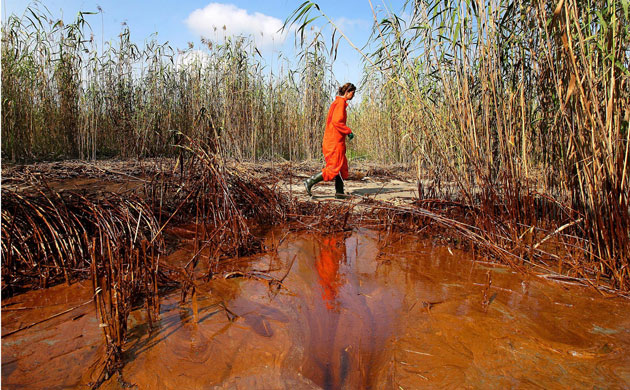
Tuesday, 11th May - Dead dolphins wash up on the coast. It emerges that workers aboard the exploding offshore drilling platform were told to sign statements denying they were hurt or that they had witnessed the blast that rocked the rig, according to their attorneys.
Wednesday, 12th May - CBS News is the first media outlet to raise the specter of detonating a nuclear bomb to fuse the gaping hole on the sea floor. The Soviets apparently did this with some success at remote inland oil leaks, as a last resort.
Some always manage to see the silver lining: the Kerry-Lieberman Cap-and-Trade bill is back on the cards, in the name of saving the climate of course, thanks to the disaster.
Thursday, 13th May - BP officials finally made public an underwater video of its broken well gushing oil into the Gulf of Mexico, after being pressured to do so by media outlets and the White House, and then claimed they hadn't received requests for the footage until then.
Friday, 14th May - BP tries to insert a tube into the leaking pipe and prepares a "junk shot" for "sometime around the end of next week" that would inject tire pieces and golf balls, to be followed by injecting "heavy mud" (really a toxic solution of water and chemicals) and then cement to plug the wound. Obama gave credence to the insane rumors that nuclear weapons were on the table by sending a team of nuclear physicists to the Gulf.
It emerges that an oil spill occurred from a pipeline operated jointly by Chevron and BP two weeks before the Deepwater explosion. The US Coast Guard estimated that 18,000 gallons of crude oil washed through the Delta National Wildlife Refuge near Venice, Louisiana. Meanwhile "odd smells" were being reported in New Orleans, with many residents suspecting the "chemical smell" was wafting in from the giant oil slick out to sea.
Sunday 16th May - Bombshell as The New York Times reports that scientists calculate as much as 3.4 million gallons of oil could be leaking into the Gulf every day - 16 times more than previously thought.
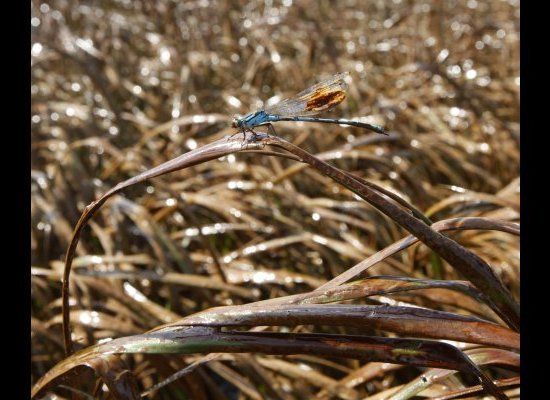
Monday 17th May - It's becoming apparent that this is an ecological disaster on a scale never seen before. The oil slick is far bigger than previously reported ("100 miles long and 40 miles wide") and the threat to marine life is total. Below the surface enormous plumes of oil are beginning to loop throughout the Gulf. New Scientist reports that "surface slicks may account for as little as 2 per cent of the oil now spilling into the Gulf of Mexico."
Tuesday 18th May - The first reports of tarballs reaching Florida's Key West. Florida Democrat Senator Bill Nelson says "this is looking like really out-of-control bad."
A CBS News crew was told to "turn around or be arrested" by a boatload of BP contractors (and two token Coast Guard officers) as it tried to film a beach with heavy oil on the shore in South Pass, Louisiana, bringing to light how closely the government and BP are working together to keep details of the disaster in the dark.
Thursday 20th May - Worst fears are realised as the first images emerge of oil spreading throughout the Louisiana marshes "at a rapid pace". Meanwhile European Space Agency satellites showed oil being pulled into the powerful clockwise-moving Loop Current that joins the Gulf Stream, the northern hemisphere's most important ocean current system. Further suggesting that this was becoming an environmental disaster of global proportions was that Congress was told that around 104,000 barrels of oil is jetting out of the well each day. That is upwards of 4,000,000 US gallons.
Friday 21st May - BP denies that it's keeping strict control of press coverage from the affected areas, but the cat is already out of the bag following th CBS News report of Tuesday 18th. At this point, it's obvious even to the compliant US media that a cover-up is in full operation. The New York Times reports that, "Tensions between the Obama administration and the scientific community over the gulf oil spill are escalating, with prominent oceanographers accusing the government of failing to conduct an adequate scientific analysis of the damage and of allowing BP to obscure the spill's true scope."
Independent researcher Dr. Robert Bea reports that "This disaster was preventable." One of the key pointers suggesting criminal negligence was the early warning signs of belches or 'kicks' of methane gas, which came up from the depths of the well in the weeks before the accident. One incident was serious enough to shut the well down.
At this point, the oil spill's surface slick is larger than the US states of Maryland and Delaware combined.
Sunday 23rd May - Highlighting the extent to which government regulators have submitted legal authority to corporations, BP rebuffs the US Environmental Protection Agency's order to halt its use of Corexit, 715,000 gallons of which has been used to this point, and switch to a less toxic dispersant.
Monday 24th May - Exasperated Louisiana officials do what the federal government won't by overriding official protocol to commandeer BP boats for the spill cleanup:
Louisiana governor Bobby Jindal said he supported a decision by local and Jefferson Parish leaders on Grand Isle on Saturday to commandeer about 30 fishing vessels that BP had commissioned but hadn't deployed to lay down protective boom as the oil came ashore.A disturbing report in The Guardian, citing the Lawrence Livermore National Laboratory, explained that when released on a large scale, methane hydrates can even cause tsunamis. This explosive hazard is the most significant factor hampering efforts to stop the gushing oil well: "the cofferdam that BP lowered over the broken pipe gushing oil to contain the spill was almost immediately clogged by methane hydrates."
The normally dispassionate Jindal even joked that he would go to jail with the mayors of Grand Isle and Jean Lafitte if federal authorities tried to stop them.
SOTT.net published a report in 2005 that illustrates how oil executives were fully aware of the hazards presented by methane hydrates in the Gulf of Mexico. It was known that trillions of cubic meters of the gas in hydrate form lay mingled with the deep sea oil deposits in the Gulf of Mexico. It was also known that upsetting these pockets of methane can trigger gigantic underwater landslides, prompting tsunamis above water.
Scientists hypothesize, in fact, that 8,000 years ago, decomposing hydrate helped to generate a gigantic landslide under the North Sea. The resulting tsunami scoured the Norwegian fjords and scattered seafloor sediment across Holland and Scotland.Charlie Paull, a geochemist at Monterey Bay Aquarium Research Institute in Moss Landing, California, warned that, "When drilling, oil engineers usually just roar right through the zone where hydrate is stable."
Despite the so-called moratorium on new deep sea drilling licenses, it is reported that the US government continues to give oil drillers environmental waivers:
"At least six of the drilling projects that have been given waivers in the past four weeks are for waters that are deeper - and therefore more difficult and dangerous - than where Deepwater Horizon was operating," the New York Times' Ian Urbina wrote Monday. "While that rig, which was drilling at a depth just shy of 5,000 feet, was classified as a deep-water operation, many of the wells in the six projects are classified as "ultra" deep water, including four new wells at over 9,100 feet."
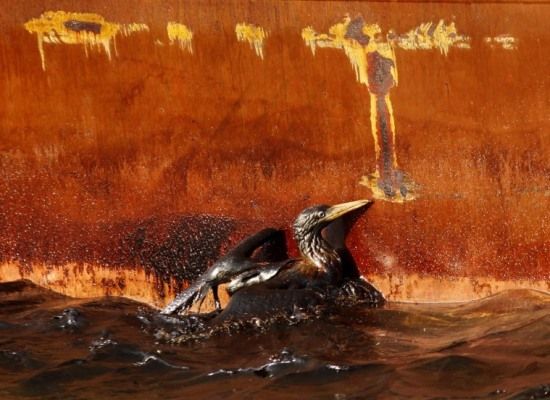
Wednesday 26th May - MSNBC's Rachel Maddow highlights how the unfolding catastrophe mirrors an eerily similar oil spill in the Gulf of Mexico in 1979. Exactly the same procedures were followed as in the current attempt to plug the well, but in the end it only stopped when the well emptied many months later.
More press photographers come forward with reports that BP and government officials are aggressively preventing them from documenting the damage.
Fishermen hired by BP to assist with cleaning up its mess become ill after working long hours near waters fouled with oil and dispersant. They report severe headaches, dizziness, nausea and difficulty breathing from the fumes of the surface oil alone. Many of them felt they had no choice but to take up BP's offer as the closure of fisheries and widespread contamination of fishing waters left them unemployed.
Matt Simmons, oil industry insider, tells MSNBC's Dylan Ratigan that "there's a much bigger leak 5 or 6 miles away" from the original site.
Thursday 27th May - Obama plays politics over the "resignation" of Elizabeth Birnbaum, head of the scandal-plagued Minerals Management Service. It turns out that she was fired, despite having landed the job long after the damage was done in terms of gutting deep sea drilling regulations.
US media excitedly broadcast the White House's declaration that the "top kill" method had worked. The leak was stopped and the hole plugged.
Friday 28th May - Actually, BP hit a "snag". "Top kill" failed. Oil, mud and methane was still gushing from the well "like a volcano."
A day after scientists reported finding a huge plume of oil extending miles east of the leaking BP well, James H. Cowan Jr., a professor at Louisiana State University, said his crew located another vast plume of oil, miles in the opposite direction.
A White House correspondent reveals that Obama's Press Secretary Gibbs had privately scolded the Washington press corps for "asking too many questions" about BP, while Obama calls a press conference to announce that the government was taking charge of the operation, over 5 weeks since the Deepwater explosion. Too little, far too late.
The New York Times reports that just days before the explosion, BP "used cheaper casing on the oil well to save money".
Saturday 29th May - The case for criminal negligence strengthens as Douglas Harold Brown, the top mechanic and acting engineer on the Deepwater Horizon, informs the House Judiciary Committee that "downsizing by Transocean had contributed to a breakdown of basic safety measures."
A lengthy Wall Street Journal analysis published Thursday, and based on internal BP and Transocean documents, reveals other ways in which BP sped along the well-capping process. Among other decisions, BP expedited a procedure involving drilling fluid that is normally used to detect gas in a well and passed over a usual quality test of the durability of cement around the rig's riser. It did so in spite of warnings from cement contractor Halliburton, which had said the rig risked "a SEVERE gas flow problem." Many of BP's decisions to speed up or bypass usual steps in the capping process were approved by the Minerals Management Service, according to the report.Criminal complicity all round then.
Sunday 30th May - The Obama administration "comes clean" and admits that it has all but given up hope of containing the gushing oil well. The US government is "prepared for the worst," expecting oil to keep gushing until relief wells are finished sometime in August.
BP announces that the "top kill" effort to stop the Gulf oil leak failed. It will resume spraying chemical dispersants, even as BP workers are increasingly being sent to hospital with illnesses.
BP's CEO Tony Hayward, denies there are any large undersea plumes from the Gulf oil spill, despite scientists from several universities reporting plumes of oil suspended in clouds that stretch for miles and reach hundreds of feet beneath the Gulf's surface, Hayward said the oil is on the water's surface, and that BP's sampling shows "no evidence" of oil in the water column. His comments confirm their damage-limitation PR strategy of using toxic dispersants to reduce the visible impact of the spill and their own 'research' to try and talk down just how bad this disaster will be.
But is damage control the only thing on BP's mind? Reporter for Natural News Mike Adams doesn't think so, and neither do many residents of the Gulf Coast. Adam's interviewed several people who have worked for BP and they are adamant, he claims, that BP is not so much interested in stopping the spill as in capturing the oil. The point seems well made; every effort BP has made so far has been to siphon off the oil not plug the leak for good. As Adam's notes:
To collapse the well and plug it for good would destroy BP's chance to siphon off oil and sell it for profit (until at least August, when the pressure relief wells are expected to be completed). And that is perhaps the single most important reason why oil is still flowing out of that well right now.Just how bad will it be?
We know the immediate environmental impact on marine life in the Gulf of Mexico is catastrophic. The economic impact on fishing and tourism maybe unrecoverable. Will the August relief drilling be successful? Or will the gushing leaks continue spewing until the massive reserves are exhausted? How much of the hidden oil will the oncoming hurricane season dump on coastal areas or further inland? And will the lingering toxic fumes make living in the Southern States a humanitarian crisis?
There are many speculative predictions circulating the internet: Will the vacuum created by the unchecked gusher swallow and heat seawater to create a tsunami that destroys the southern states? Will the massive quantities of methane hydrates cause further geological disruption and earthquakes? Will toxic dispersants evaporate and fall across north America in acid rain showers? Will this lead to the death of the worlds oceans and our ultimate extinction?
The truth is no one really knows. Or if they do, we can guarantee it will not make the front page headlines of the mainstream media. To protect their profits, BP will continue to employ its PR machine to under-report the true magnitude of this disaster and their legal team work overtime to drag-out and defend the myriad of law suits they are facing for many years to come.
Only after the last ocean has been destroyed, Only after the last river has been poisoned, Only after the last fish has been killed, Only then will you find that oil cannot be eaten.
-- BP Prophecy
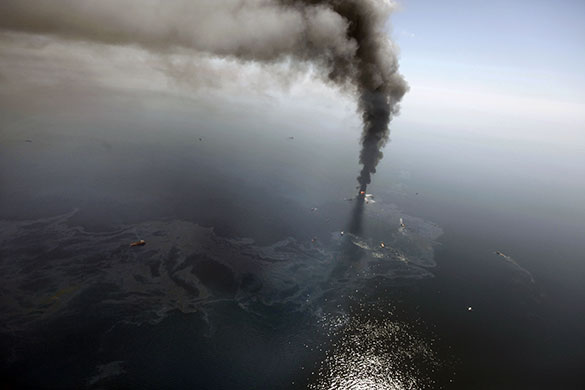
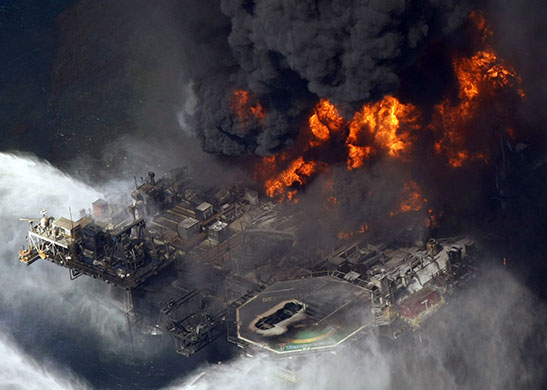
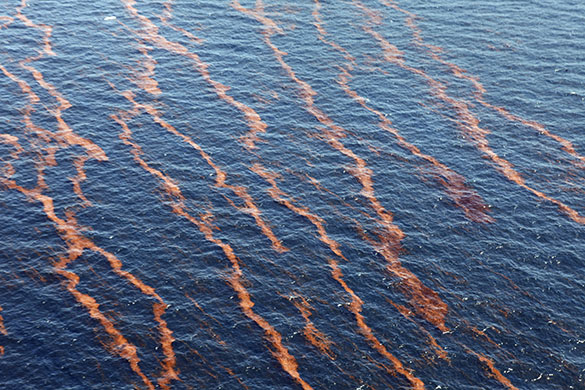
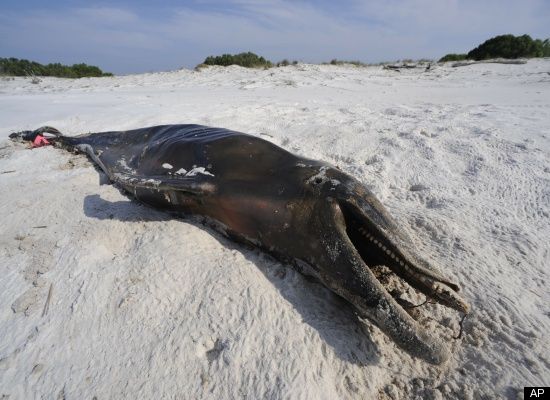
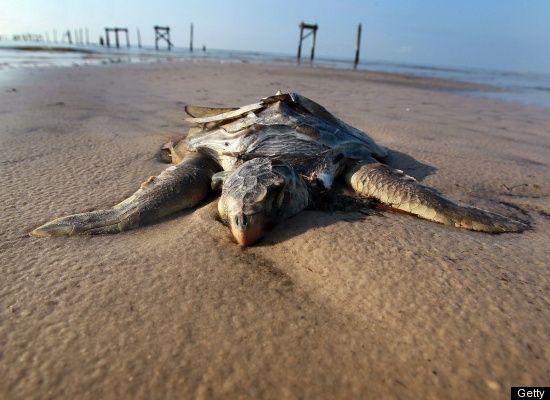



The people who have Clif High's "Shape of Things to Come" v0i2 released last 15 September 2009 should look at the last paragraph on page 13 of the PDF - my excerpt: "degradation of the oceanic food chain will seriously impact humans and amplify the famine of 2010/2011".